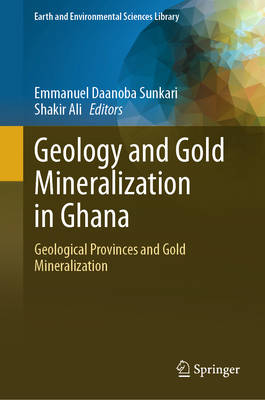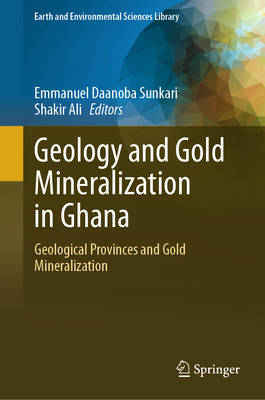
- Retrait gratuit dans votre magasin Club
- 7.000.000 titres dans notre catalogue
- Payer en toute sécurité
- Toujours un magasin près de chez vous
- Retrait gratuit dans votre magasin Club
- 7.000.0000 titres dans notre catalogue
- Payer en toute sécurité
- Toujours un magasin près de chez vous
Geology and Gold Mineralization in Ghana
Geological Provinces and Gold Mineralization
274,95 €
+ 549 points
Description
The book provides a comprehensive overview of the various geological provinces in Ghana, with a major emphasis on the gold mineralization styles. Specifically, it elucidates the geology of Ghana in the context of gold deposits.
Ghana is located in the Leo-Man Shield of the West African Craton (WAC), enriched in several precious mineral deposits, especially gold, and hence was once called Gold Coast before independence in 1957. Today, Ghana is the largest gold producer in Africa and the sixth largest globally. Gold production in the country constitutes about one-third of the country s total revenue. Gold deposits in Ghana have been exploited for centuries. However, except for a few isolated and, probably, old literature, knowledge gaps towards understanding gold mineralization styles in Ghana are evident. Also, studies related to the genesis of the major types of gold mineralization in Ghana are inadequate. Therefore, this book mainly focuses on comprehensively describing the geology of Ghana and establishing the link between the geology and gold mineralization. The contributions involve current state-of-the-art knowledge of gold deposits based on field studies, petrology, structural geology, geodynamic settings/tectonics, geochemistry, isotope geology, economic geology, and related studies.
The book is divided into five parts, covering all the aspects of the geology and gold mineralization in Ghana. The first part introduces readers to the geology and gold mineralization styles in Ghana and provides a brief description of the occurrence and general geological features of the main gold deposit types in Ghana. The second part features the structural controls on gold deposits in Ghana since gold mineralization in the country is primarily structurally controlled. Moreover, since the gold deposits in Ghana are largely hosted in lithologies belonging to the Birimian Supergroup and the Tarkwaian Group, the petrogenesis of these lithologies is discussed in the third part. In the fourth part, the geology, mineralogy, geochemistry, fluid evolution, and genesis of hydrothermal gold deposits in Ghana are discussed. Finally, in the last part, readers will find the application of new techniques like machine learning in predicting gold-bearing lithologies in Ghana. The book would provide a conceptual framework for identifying gaps in future research on gold mineralization in the country. The book will be helpful to students/researchers/faculty members studying Earth Science-related programs and also assist industries in understanding the various rock types in Ghana and the general styles of gold mineralization. It can be used as a textbook at higher levels of education in the country and globally.
Ghana is located in the Leo-Man Shield of the West African Craton (WAC), enriched in several precious mineral deposits, especially gold, and hence was once called Gold Coast before independence in 1957. Today, Ghana is the largest gold producer in Africa and the sixth largest globally. Gold production in the country constitutes about one-third of the country s total revenue. Gold deposits in Ghana have been exploited for centuries. However, except for a few isolated and, probably, old literature, knowledge gaps towards understanding gold mineralization styles in Ghana are evident. Also, studies related to the genesis of the major types of gold mineralization in Ghana are inadequate. Therefore, this book mainly focuses on comprehensively describing the geology of Ghana and establishing the link between the geology and gold mineralization. The contributions involve current state-of-the-art knowledge of gold deposits based on field studies, petrology, structural geology, geodynamic settings/tectonics, geochemistry, isotope geology, economic geology, and related studies.
The book is divided into five parts, covering all the aspects of the geology and gold mineralization in Ghana. The first part introduces readers to the geology and gold mineralization styles in Ghana and provides a brief description of the occurrence and general geological features of the main gold deposit types in Ghana. The second part features the structural controls on gold deposits in Ghana since gold mineralization in the country is primarily structurally controlled. Moreover, since the gold deposits in Ghana are largely hosted in lithologies belonging to the Birimian Supergroup and the Tarkwaian Group, the petrogenesis of these lithologies is discussed in the third part. In the fourth part, the geology, mineralogy, geochemistry, fluid evolution, and genesis of hydrothermal gold deposits in Ghana are discussed. Finally, in the last part, readers will find the application of new techniques like machine learning in predicting gold-bearing lithologies in Ghana. The book would provide a conceptual framework for identifying gaps in future research on gold mineralization in the country. The book will be helpful to students/researchers/faculty members studying Earth Science-related programs and also assist industries in understanding the various rock types in Ghana and the general styles of gold mineralization. It can be used as a textbook at higher levels of education in the country and globally.
Spécifications
Parties prenantes
- Editeur:
Contenu
- Nombre de pages :
- 260
- Langue:
- Anglais
- Collection :
Caractéristiques
- EAN:
- 9783031971624
- Date de parution :
- 02-08-25
- Format:
- Livre relié
- Format numérique:
- Genaaid
- Dimensions :
- 156 mm x 234 mm
- Poids :
- 557 g

Les avis
Nous publions uniquement les avis qui respectent les conditions requises. Consultez nos conditions pour les avis.





